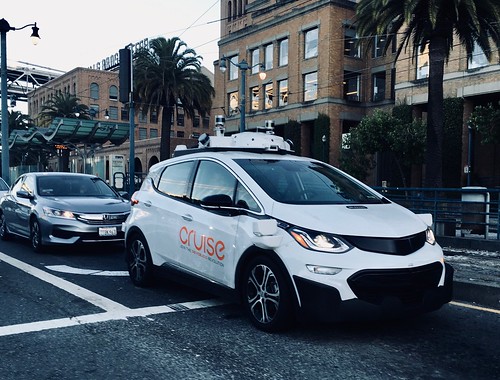San Francisco streets have become ground zero for a peculiar form of protest against robotaxis cruising neighborhoods as self-driving car companies ramp up testing.
- Video thanks to ABC7 News Bay Area.
Numerous social media posts reveal traffic cones strategically placed on streets to befuddle autonomous vehicles operated by General Motors’ Cruise unit and other firms. Videos show empty robotaxis halted awkwardly by the harmless plastic obstacles apparently intended to passively impede progress.
Internet investigators have dubbed the unknown instigators “robotaxi haters” though their precise motives remain cryptic. Regardless, the cone placements showcase limitations in today’s AV systems forced to freeze upon encountering even modestly abnormal environments.
Robotaxi Services Expanding in the City
Over 30 companies currently test autonomous vehicles across San Francisco including big players like Cruise, Waymo and Uber. The density allows for efficient data collection to train vehicle perception systems for navigation in complex urban terrain.
Cruise received a permit to offer fully driverless commercial robotaxi service in parts of the city late last year. Its fleet of sensor-laden Chevrolet Bolt EVs have been mapping routes while aiming to further develop capabilities and public trust.
Waymo, Alphabet’s self-driving division, also offers a public robotaxi program named Firefly with safety drivers present. Meanwhile Apple utilizes sensor-equipped Lexus SUVs to collect visual data to likely bolster its secretive self-driving car efforts, spotted frequently on city streets.
The expansion of robotaxi presence hasn’t sat well with everyone though.
Mysterious Traffic Cones Tripping up AVs
Documented primarily via Twitter, the situations involve traffic cones positioned on local roads known to be frequented by General Motors’ driverless Cruise taxis during testing.
Videos capturing the encounters of robotaxi haters cones in san francisco, revealing the fully autonomous Cruises braking hard then sitting motionless upon registering the cones. The cars appear utterly stumped, lacking logic to bypass what a human would instantly process as a harmless obstacle.
No known party has claimed credit for strategically planting the cones. Online commenters have playfully dubbed the phantom activists “AV haters” though their motives range from humorous mischief to serious concerns over driverless car safety.
Exposing Self-Driving Limitations
Whatever the underlying rationale, the cone placements effectively demonstrate shortcomings in today’s AV systems. Stationary plastic cones should pose little issue for a properly trained neural network.
Current self-driving stacks rely heavily on precisely mapped routes with any unknown variables risking hazardous system confusion. This remains a key challenge for real world reliability.
Cruise downplayed the incidents as valuable edge case data collection, saying their systems are rapidly improving to handle novel inputs. However some industry voices argued Cruise should geo-fence areas prone to such mischief until better equipped.
The cone capers illustrate progress remains across edge case identification, creative problem solving and graceful recovery protocols. Before governments permit commercial driverless services en masse, the public needs reassurance with such demonstrations of lingering deficiencies.
Until autonomous driving technology advances further and wins over more hearts and minds, “robotaxi haters” simmering in San Francisco seem unlikely to tolerate self-driving fleets in their neighborhoods without additional speed bumps.
